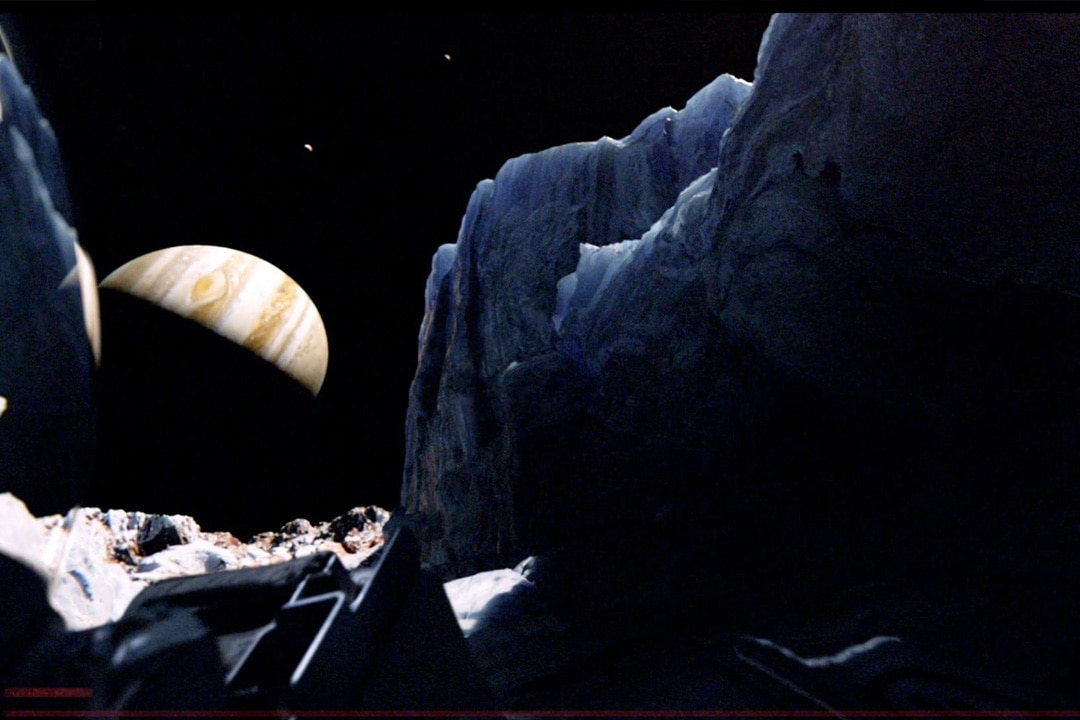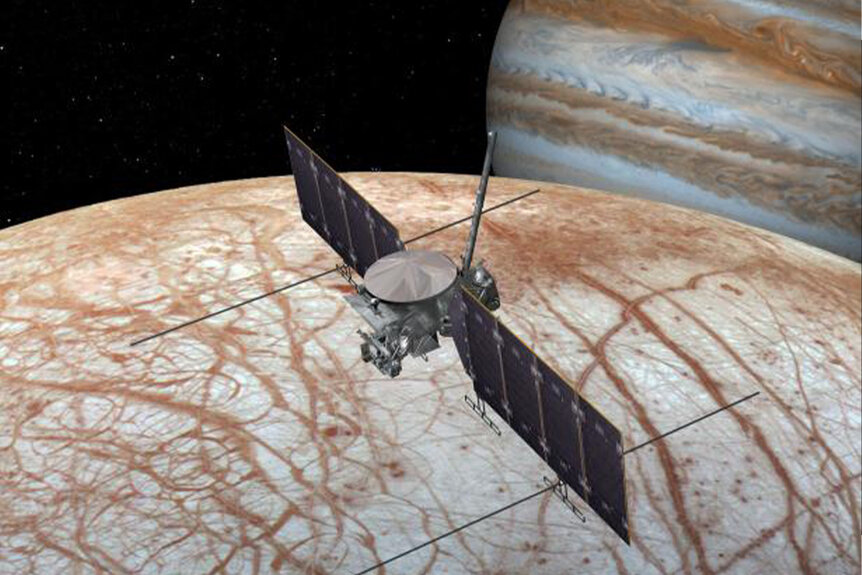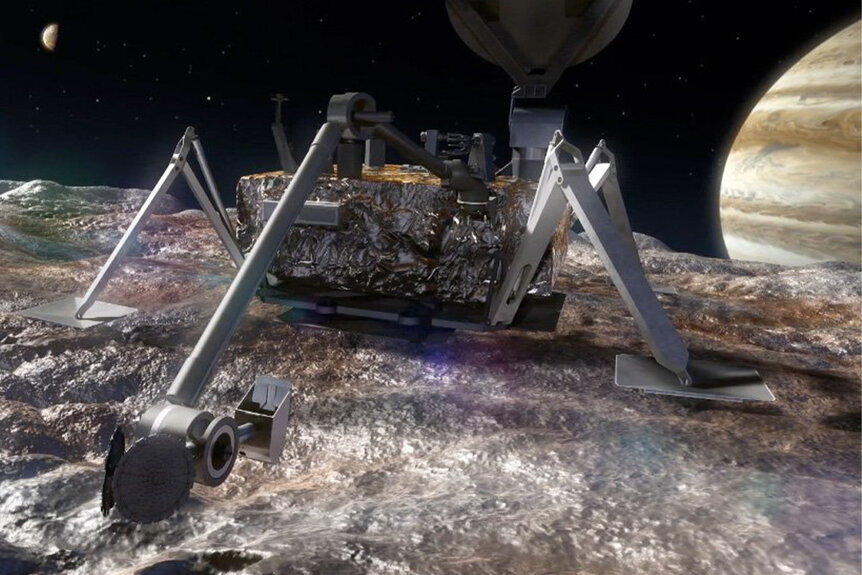Create a free profile to get unlimited access to exclusive videos, sweepstakes, and more!
Searching for life on Europa: The science behind 'Europa Report'
Be careful what you look for.

A decade ago, audiences were treated to an adventure into the far reaches of our solar system. Six astronauts board a state of the art spacecraft on an exploratory mission to Jupiter’s moon Europa, in Europa Report, streaming now on Peacock! After a 20-month journey to the suburbs of the solar system, the crew touches down on the icy surface of Europa.
They’re hunting for signs of life, either past or present, and holy smokes do they find it. Almost as soon as they crack through the moon’s icy covering and into the globe-spanning saltwater ocean beneath, they encounter strange blue lights. Hints of bioluminescent (emphasis on the bio) creatures living in the waters beneath Europa’s frozen surface.
RELATED: It may be snowing upside down in the water beneath Europa’s surface
The doomed crew of the Europa One were destined never to return home, but the results of their exploration did. Sent at the speed of light from an alien world to our home world, audio and video recordings confirmed once and for all that humanity is not alone in the universe. Although, considering the kind of life they fictionally found on Europa, maybe it was better when we thought there was nobody else in the house with us. Regardless of the potential perils, humanity is determined to go to Europa sooner than later, here’s how.
EUROPA CLIPPER
Europa is of particular interest to scientists because it has many of what we think are the key ingredients for the emergence of life. From the outside, Europa looks like a ball of ice, frozen solid, but that couldn’t be further from the truth. Scientists are confident that there is a globe-spanning liquid water ocean just beneath the surface ice. You might wonder how an icy moon so far from the Sun could end up with a massive sub-surface ocean, so we’ll tell you.
The Jovian system is complicated. It’s almost like an entire solar system compressed into a smaller space. At the center of the system is Jupiter, the second most massive object in the solar system, after the Sun. Around Jupiter, orbit dozens of moons, all of which are constantly pulling on the planet and on one another. To be a moon in the Jovian system is to be pulled in half a hundred directions all at the same time. Europa is feeling the gravitational pull of the Sun, of Jupiter, and of the dozens of other moons in its vicinity. All of that pushing and pulling generates enough friction in the core to keep it molten and provide a source of heat and energy to the ice. Europa’s exterior is plenty cold to freeze water ice but, go down a little way and you’ll find a liquid ocean sandwiched between the ice and the moon’s crust.
The Europa Clipper spacecraft is designed to carry out detailed recon on the icy world, including figuring out if it has conditions suitable for life. We’re pretty sure it does, but there is a lot of wiggle room between technically good enough for life and the sort of thriving environment we imagine. We know that Europa has liquid water, and we suspect that the moon facilitates the transport of salts and oxygen between the surface and subsurface, thanks to fractures in the ice. Europa has most of the necessary pieces for doing the sorts of chemistry which could result in life.
Europa Clipper is planned for launch in October 2024, with a planned orbital insertion around Jupiter sometime in 2030. Rather than orbit Europa directly, which would expose the craft to the ceaseless radiation of Jupiter’s intense magnetosphere, the craft will instead go into an elliptical orbit around the planet itself. That way, Clipper will alternate between being close to Jupiter and farther away, minimizing radiation damage from the planet. As a result, Europa Clipper wont’ be close to Europa all of the time, but it will complete roughly 50 flybys as it orbits Jupiter. As of this writing, the main body section of Europa Clipper has completed construction in advance of a planned launch next year.
EUROPA LANDER
Europa Clipper will undoubtedly extend our knowledge and understanding of one of the most interesting objects in the solar system, but it probably won’t answer the question of if life exists there. To do that, we’ll likely need to land on the surface to get an even closer look. Unlike Europa Clipper, a landing mission to Europa has no planned launch date and no firm design for a landing craft. There is, however, a proposal.
A spacecraft (let’s call it Europa Dipper) would land on Europa to collect underground samples. Those samples could come from just a few inches beneath the surface (four inches is enough ice to protect any potential alien microbes from solar radiation) or they could come from much deeper. Surface samples could be analyzed by a mini lab aboard the craft, similar to the ways Martian rovers collect and analyze materials on the Red Planet. An onboard seismometer would also be of interest, given the given the likelihood of quakes in a solid surface made of floating water ice.
RELATED: First closeup picture of Europa in 20 years reveals rugged terrain and degraded crater
The materials from the 2020 Europa / Ocean Worlds Lander Virtual Meeting beautifully illustrate the complex activity potentially occurring on Europa. Underwater geothermal vents provide heat, energy, and nutrients. Cracks in the ice allow oxygen and salts to flow back and forth, and the temperature difference between the vents on the ocean floor and the frozen surface ice help to drive ocean currents, further mixing nutrients and chemical compounds into the water column.
It's possible that a lander could find evidence of life as shallow as four inches beneath the surface, but if we’re going to go all that way (roughly 500 million kilometers, give or take) then we might as well go the distance. There’s no reason to stumble at the finish line. An ideal lander would be capable of touching down on the surface, drilling through the ice, and exploring the subsurface ocean beneath. That could be accomplished by a single amphibious spacecraft or by one craft carrying another, similar to the way Perseverance carried Ingenuity so it could cruise the Martian skies. For Europa, we’d need not a drone helicopter, but the first extraterrestrial submarine.
If there is life on Europa, there’s a good chance it popped up there independently, as opposed to being the result of life hopping from one world to another on an asteroid or something. If that’s true, it could mean that the emergence of life is more common than we supposed. To find it two separate times in the same solar system would suggest that the galaxy and the whole of the universe is littered with alien amigos for us to find.
From the safety of your own home, catch Europa Report, streaming now on Peacock!




























